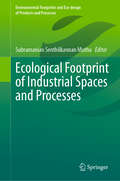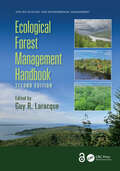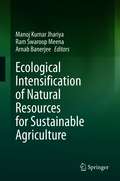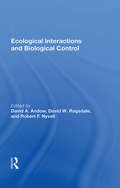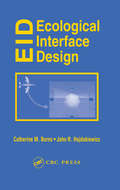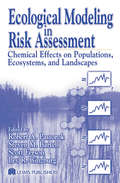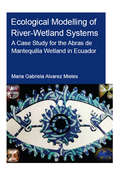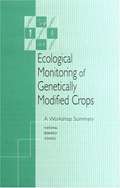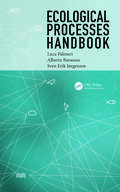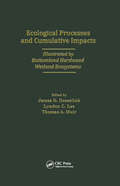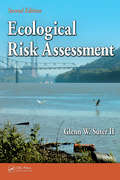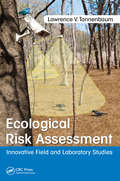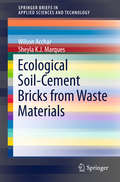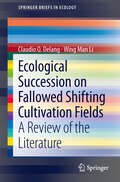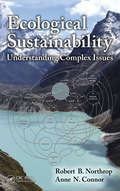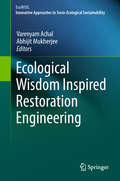- Table View
- List View
Ecological Footprint of Industrial Spaces and Processes (Environmental Footprints and Eco-design of Products and Processes)
by Subramanian Senthilkannan MuthuThis book describes and offers cases in the assessment of Ecological Footprint (EF) in different industrial spaces and processes. Ecological Footprint is a useful metric that measures the level of resources from the environment that are required to support a specific way of life or business. This book enumerates the concept of EF and how this concept can be applied to a variety of industrial spaces and processes including textile manufacture, electric vehicle charging, construction materials, and agriculture.
Ecological Forest Management
by Jerry F. Franklin K. Norman Johnson Debora L. JohnsonFundamental changes have occurred in all aspects of forestry over the last 50 years, including the underlying science, societal expectations of forests and their management, and the evolution of a globalized economy. This textbook is an effort to comprehensively integrate this new knowledge of forest ecosystems and human concerns and needs into a management philosophy that is applicable to the vast majority of global forest lands. Ecological forest management (EFM) is focused on policies and practices that maintain the integrity of forest ecosystems while achieving environmental, economic, and cultural goals of human societies. EFM uses natural ecological models as its basis contrasting it with modern production forestry, which is based on agronomic models and constrained by required return-on-investment. The book concludes with an overview of how EFM can contribute to resolving major 21st century issues in forestry, including sustaining forest dependent societies.
Ecological Forest Management Handbook (Applied Ecology and Environmental Management)
by Guy R. LarocqueThe second edition of Ecological Forest Management Handbook continues to provide forestry professionals and students with basic principles of ecological forest management and their applications at regional and site-specific levels. Thoroughly updated and revised, the handbook addresses numerous topics and explains that ecological forest management is a complex process that requires broad ecological knowledge. It discusses how to develop adaptive management scenarios to harvest resources in a sustainable way and provide ecosystem services and social functions. It includes new studies on ecological indicators, the carbon cycle, and ecosystem simulation models for various forest types: boreal, temperate, and tropical forests.NEW IN THE SECOND EDITION Provides a comprehensive collection of sustainable forest management principles and their applications Covers new ecological indicators that can be applied to address forest environmental issues Includes all types of models: empirical, gap, and process-based models Explains several basic ecological and management concepts in a clear, easy-to- understand manner This handbook is intended for researchers, academics, professionals, and undergraduate and graduate students studying and/or involved in the management of forest ecosystems.Chapters 16 and 18 of this book are available for free in PDF format as Open Access from the individual product page at www.taylorfrancis.com. They have been made available under a Creative Commons Attribution-Non Commercial-No Derivatives 4.0 license.
Ecological Impacts of Tsunamis on Coastal Ecosystems
by Tohru Nakashizuka Jotaro UrabeThis book focuses on the ecological impacts of the Great East Japan Earthquake and resulting tsunamis, a rare and extremely large disturbance event, on various coastal ecosystems in Japan's Tohoku area, including sub-tidal and tidal animal communities, sand dune plant communities and coastal forests. The studies presented here describe not only how species and populations in these ecosystems were disturbed by the earthquake and tsunamis, but also how the communities have responded to the event and what types of anthropogenic activities will hamper their recovery processes. In the ecological sciences, it is often argued that large disturbances are critical to shaping community structures and biodiversity in local and regional habitats. However, our understanding of these roles remains limited, simply because there have been few opportunities to examine and address the ecological impacts of large disturbance events. The scale of the 2011 Great East Japan Earthquake makes it one of the largest hazards in the past 1000 years. Thus, this book provides a unique opportunity to advance our understanding of the ecological impacts of large and rare disturbances and the implications of these events in the conservation and management of coastal ecosystems. Following an outline of the Great East Japan Earthquake, the book's content is divided into two major parts. Part I reports on studies examining the ecological impacts of the tsunamis on sub-tidal and tidal animal communities, while Part II focuses on terrestrial plant communities in Japan's coastal Tohoku area. This book will benefit all scientists interested in the ecological impacts of large disturbances on aquatic and terrestrial ecosystems in general, and especially those who are interested in the ecological management of coastal ecosystems and Ecosystem based Disaster Risk Reduction (EcoDRR).
Ecological Intensification of Natural Resources for Sustainable Agriculture
by Ram Swaroop Meena Manoj Kumar Jhariya Arnab BanerjeeEcological intensification involves using natural resources such as land, water, soil nutrients, and other biotic and abiotic variables in a sustainable way to achieve high performance and efficiency in agricultural yield with minimal damage to the agroecosystems. With increasing food demand there is high pressure on agricultural systems. The concept of ecological intensification presents the mechanisms of ensuring high agricultural productivity by restoration the soil health and landscape ecosystem services. The approach involves the replacement of anthropogenic inputs with eco-friendly and sustainable alternates. Effective ecological intensification requires an understanding of ecosystems services, ecosystem's components, and flow of resources in the agroecosystems. Also, awareness of land use patterns, socio-economic factors, and needs of the farmer community plays a crucial role. It is therefore essential to understand the interaction of ecosystem constituents within the extensive agricultural landscape. The editors critically examined the status of ecological stress in agroecosystems and address the issue of ecological intensification for natural resources management. Drawing upon research and examples from around the world, the book is offering an up-to-date account, and insight into the approaches that can be put in practice for poly-cropping systems and landscape-scale management to increase the stability of agricultural production systems to achieve ‘Ecological resilience’. It further discusses the role of farmer communities and the importance of their awareness about the issues. This book will be of interest to teachers, researchers, climate change scientists, capacity builders, and policymakers. Also, the book serves as additional reading material for undergraduate and graduate students of agriculture, forestry, ecology, agronomy, soil science, and environmental sciences. National and international agricultural scientists, policymakers will also find this to be a useful read for green future.
Ecological Interactions And Biological Control
by David A. Andow David W. Ragsdale Robert F. NyvallRecent interest in nonchemical methods of pest control has brought renewed attention to the biological control of plant pests in the fields of entomology, plant pathology, and weed science. Ecological Interactions and Biological Control addresses issues of theory and practice common to all three fields. Focusing on systems rather than on individual
Ecological Interface Design
by Catherine M. Burns John HajdukiewiczEcological Interface Design delivers the techniques and examples that provide you with a foundation to succeed in designing advanced display graphics. The opening chapters introduce the "art" of interface design by exposing the analytical methods behind designs, the most common graphical forms, and how these methods and forms are pulled together to create a complete design.The book then incorporates case studies that further emphasize techniques and results. Each example exemplifies a solution to a certain part of the EID puzzle. Some of the examples demonstrate the analysis phase, while others apply more scrutiny to graphical design. Each is unique, allowing allowing you to use them in the development of your own designs. The volume concludes with an analysis that connects ecological interface design with other common interface design methods, enabling you to better understand how to combine approaches in the creation of design solutions.
Ecological Modeling in Risk Assessment: Chemical Effects on Populations, Ecosystems, and Landscapes
by Scott Ferson Lev R. Ginzburg Steven M. Bartell Robert A. PastorokExpanding the risk assessment toolbox, this book provides a comprehensive and practical evaluation of specific ecological models for potential use in risk assessment. Ecological Modeling in Risk Assessment: Chemical Effects on Populations, Ecosystems, and Landscapes goes beyond current risk assessment practices for toxic chemicals as applied to individual-organism endpoints to describe ecological effects models useful at the population, ecosystem, and landscape levels. The authors demonstrate the utility of a set of ecological effects models, eventually improving the ecological relevance of risk assessments and making data collection more cost effective.
Ecological Modelling of River-Wetland Systems: A Case Study for the Abras de Mantequilla Wetland in Ecuador (IHE Delft PhD Thesis Series)
by Maria Gabriela Alvarez MielesAround 6% of the Earth's land surface is covered by wetlands. Wetlands play a key role in hydrological and biogeochemical cycles, delivering multiple benefits to society: sources of water supply, flood regulation, water purification, agriculture, fisheries, and biodiversity. Hence, wetland systems are of immense socio-economic as well as ecological importance. In this research, the focus was on the Abras de Mantequilla (AdM) wetland in the tropical coastal region of Ecuador, a RAMSAR site and case study area for the EU-FP7 WETwin project. The research in this thesis involves a combination of field data collection, multivariate analysis techniques, as well as numerical modelling studies. The goal was to explore the effects of changes in hydrological forcing on the hydrodynamic and ecohydraulic responses of the wetland. The study aims to contribute to the understanding of how a tropical river-wetland system functions in terms of hydrodynamics, water quality, primary production, and biotic communities. Spatial patterns of biotic communities and environmental variables are obtained as well as spatio-temporal variability of hydrodynamics, water quality, primary productivity and fish habitat-suitability conditions. In data scarce areas and countries with financial constraints, the combination of field measurements with numerical models was extremely useful and relevant, confirming that these techniques complement each other in obtaining a better understanding of the dynamics of freshwater river–wetland systems. Studies like the present research can be used to enhance awareness about the environmental services of wetlands and stimulate cooperation between all stakeholders in order to achieve more sustainable wetland management.
Ecological Modernisation and Renewable Energy
by David TokeDevelops a new theory of 'identity' ecological modernization (EM), to analyse renewable history and policy development in many of the world's states which are leading the drive to install renewable energy. 'Identity EM' concerns how an industry has arisen allied to environmental NGOs to challenge the ascendancy of conventional energy technologies.
Ecological Monitoring of Genetically Modified Crops: A Workshop Summary
by Robert PoolInformation on Ecological Monitoring of Genetically Modified Crops
Ecological Processes Handbook (Applied Ecology and Environmental Management)
by Sven Erik Jorgensen Luca Palmeri Alberto BarausseEcology is cross-disciplinary field involving many different aspects of science. Written with this in mind, this book introduces ecological processes, ranging from physical processes, to chemical processes and biological processes. It contains all the necessary information on an ecological process: a clear, detailed but not too lengthy definition,
Ecological Processes and Cumulative Impacts Illustrated by Bottomland Hardwood Wetland EcosystemsLewis Publishers, Inc.
by Coastal Ecology InstThis timely book is a "must-have" for anyone involved with wetland conservation, in particular bottomland hardwood forests, a habitat in which over 50% of our nation's inventory has been destroyed. Authored by recognized experts, the book thoroughly covers the ecological processes in bottomland hardwood forests and relates these processes to human activities. Chapters include original research into ecological processes, discuss impacts of human activities on flood plain ecosystems, and examine human perceptions of bottomland values and management strategies for ecosystem restoration and conservation. The book focuses on impact assessment and management, featuring local sites and ecosystems, as well as the processes in larger areas, such as watersheds and hydrological basins.
Ecological Risk Assessment
by Glenn W. Suter IIThe definitive reference in its field, Ecological Risk Assessment, Second Edition details the latest advances in science and practice. In the fourteen years since the publication of the best-selling first edition, ecological risk assessment (ERA) has moved from the margins into the spotlight. It is now commonly applied to the regulation of c
Ecological Risk Assessment for Chlorpyrifos in Terrestrial and Aquatic Systems in the United States
by John P. Giesy Keith R. SolomonReviews of Environmental Contamination and Toxicology attempts to provide concise, critical reviews of timely advances, philosophy and significant areas of accomplished or needed endeavor in the total field of xenobiotics, in any segment of the environment, as well as toxicological implications.
Ecological Risk Assessment: Innovative Field and Laboratory Studies
by Lawrence TannenbaumThis book is a compendium of highly purposeful studies all waiting to be conducted. It explains how avoiding common study design flaws, opportunities are created to observe that true risk assessment questions may not exist, that chemically exposed receptors are probably unharmed, and that ecological risk assessment might not be needed at all.
Ecological Risks of Emerging Pollutants in Urbanizing Regions
by Pei Wang Yonglong Lu Jingjing YuanThis book characterizes the major pollution patterns of emerging contaminants, such as sources, emission effluents, temporal and spatial distributions, multi-media transportation and transformation processes, exposure pathways to ecosystems and humans, and ecological risks. Based on this, it establishes an urbanizing region management concept and highlights how urbanization and its regional ecology have evolved into a more integrated vision. It also decouples the relations between urbanization and emissions of emerging pollutants that are framed within a broad socio-ecological context considering institutions, policies, and governance. All the theory, methods, and case studies have been taken from the authors’ publications, which have undergone rigorous international peer review. The book presents the spatial distribution, pathways, and flow diagrams of the pollutants as well as the interactions between urbanization and regional pollution and includes detailed figures and pictures. It also investigates ecological risk characterization and expression using maps based on geographic information systems to illustrate the general profile and the spatial variation of risks. The book is a valuable resource for postgraduates, researchers, academics, environmental NGOs, and regional managers such as urban planners, environmental agency staff, legal regulators, and decision makers. Bridging the gap between environmental science and policy, it offers interdisciplinary theory, approaches, and case studies that facilitate applications of frontier science in ecology and environmental science to regional social and economic development.
Ecological Soil-Cement Bricks from Waste Materials
by Wilson Acchar Sheyla K. J. MarquesThis book proposes the use of waste from oil drilling andsugar cane bagasse ash in the production of ecologically friendly soil-cementbricks. It offers a viable alternative to the traditional bricks available onthe market, which use wood as fuel: manufacturing bricks from waste is lesscostly and does not require the consumption of trees and forests. It alsoproposes an alternative to the current discharging of the above-mentioned typesof waste in sanitary landfills, avoiding additional environmental problems.
Ecological Solutions to Agricultural Land Degradation
by Anup Das Subhash Babu Rajbir Singh Raghavendra Singh Sanjay Singh RathoreThis book provides an overview of the current status of land degradation globally and the different approaches used for its restoration. In addition to the technical aspects, it also delves into the social and economic implications of land restoration, such as in terms of policy planning. Land degradation is a serious threat to agriculture, affecting soil function and productivity. There are up to 6 billion hectares of degraded soil worldwide. It is estimated that 30% of forests, 20% of agricultural land and 10% of rangelands are severely affected by land degradation. The main causes of land degradation are soil erosion, acidification, compaction and salinization, intensive agriculture, overgrazing, poor management of arable land and deforestation. The consequences of such degradation include sand dune expansion and displacement, reduced rainfall, rangeland depletion, wind and rain erosion, and loss of biomass and biological integrity. In 2015, the global goal of achieving land degradation neutrality (LDN) was included in the 2030 Agenda for Sustainable Development as sustainable development goal 15.3. Developing productive soil ecosystems by restoring degraded soils is therefore a future perspective for food security and environmental sustainability. This can be achieved through crop rotation, agroforestry, conservation agriculture, cover crops, terrace farming, ditching, geo-jute, and contour farming and zero tillage. Ecological restoration of farmlands offers an opportunity to reconcile agricultural production with improving ecosystem services. Restoring degraded land through environmentally friendly agroecological approaches has the potential to improve agricultural production and provide healthy ecosystems for organisms. This book is an important resource for students, academics, researchers, national and international agricultural scientists, and soil experts.
Ecological Succession on Fallowed Shifting Cultivation Fields
by Claudio O. Delang Wing Man LiThe book reviews the literature on the ecological succession of plants on fallowed swiddens in tropical forests. Patterns of ecological succession in tropical forests are insufficiently understood, partly because results are scattered through a large number of case studies reported in academic articles. So far, no publication has attempted to bring these different case studies together to identify common patters and trends. The goal of the book is to review the different case studies, and identify common patterns of ecological succession in fallowed swiddens, as well as to pinpoint the factors that cause ecological succession in some areas to differ from those in other areas. The book is organised in four different sections: forest structure, forest diversity, species composition, and the factors that contribute to differences in forest recovery rates (the number of times the field was burned, the length of fallow period, the type of soil, and the type of forest). This book is an important contribution to tropical forestry and shifting cultivation. Deforestation and forest degradation are the largest sources of CO2, and shifting cultivation is one of the main culprits. For this (and other economic and political) reason governments attempt to curtail shifting cultivation by shortening the years the fields can be left fallow, or outright outlawing the farming practice. Yet, there is insufficient understanding of the processes of ecological succession in fallows, which raises the questions as to whether the policy fulfils its objectives.
Ecological Sustainability: Understanding Complex Issues
by Robert B. Northrop Anne N. ConnorComplex systems is a new field of science studying how parts of a system give rise to the collective behaviors of the system, and how the system interacts with its environment. This book examines the complex systems involved in environmental sustainability, and examines the technologies involved to help mitigate human impacts, such as renewable ene
Ecological Wisdom Inspired Restoration Engineering (EcoWISE)
by Abhijit Mukherjee Varenyam AchalThis book focuses on ecological wisdom inspired restoration engineering through theories, hypotheses, policies, practical understanding, and case studies. Understanding nature’s processes is a prerequisite for the healthy and sustainable functioning of a habitable Earth. As such, the book provides a guide for readers seeking to understand and build sustainable, urban socio-ecological systems using restoration technologies based on wisdom. Motivated by recent rapid advances in restoration engineering, such as the role of green building materials in urban infrastructures, and developing sustainable landscapes to benefit the environment, economy and communities, it is an essential reference on the most promising innovative technologies. It discusses engineering methods and practices in the restoration of soil, water, heritage sites, and other ecosystems, as well as the development and applications of green building materials. It presents a holistic and systematic approach that utilizes natural resources and the concept of ecological wisdom to reap sustainable environmental, economic and social benefits to fulfill the concept of living in harmony with nature. This book is a valuable resource for civil- and environmental engineering researchers as well as organizations engaged in eco-restoration practices.
Ecological Wisdom: Theory and Practice (EcoWISE)
by Bo Yang Robert Fredrick YoungThis book offers an introduction to the theory and practice of ecological wisdom (EW). EW is the integration of robust contemporary science with proven cultural and historical practices to identify long-term, sustainable solutions to problems of environmental management and urban design. The book combines theoretical concepts with specific case studies, illustrating the opportunities for interdisciplinary approaches combining historical experience, cultural context, and contemporary science as effective strategies for addressing complex problems confronting metropolitan and rural environmental and resource management in areas such as land use, water management, materials and building engineering, urban planning, and architecture and design. EW transcends the limitations in these fields of the normative approaches of modernity or traditional wisdom by offering a new, synthetic strategy to address socio-ecological issues. By presenting these ideas both theoretically and through existing case studies, the book provides researchers, practitioners and students with a powerful new perspective in developing long-term, resilient solutions to existing socio-environmental challenges. It is intended mainly for those working or interested in the fields of sustainable environmental and resource management, city and regional planning, architecture and design, civil engineering, landscape architecture, and the philosophy of science, particularly those with an ecological or sustainability focus.
Ecological and Digital Transition in Cities: Measuring Ecosystem Services for Urban Planning and Design (Lecture Notes in Networks and Systems #1272)
by Carmelina Bevilacqua Francesca Moraci Pasquale PizzimentiThis open access book delves into the intersection of ecological, technological, and social dynamics at the core of urban transition and the relevance of urban planning and design in addressing the pressing challenges faced by cities and regions in the 21st century. This book is held at “Networks, Markets & People” Communities, Institutions and Enterprises toward post-humanism epistemologies and AI challenges, May 22–25, 2024, Reggio Calabria, Italy. The papers included in the book follow two main drivers. The first is dedicated to discussing the concept of ecosystem services exploring the role of policy and governance mechanisms in promoting the integration of ecosystem services into urban planning and design practices. The second presents various data-driven perspectives, methodologies, frameworks, and case studies for measuring ecosystem services in cities, ranging from traditional methods to cutting-edge digital mapping and modeling techniques. The book primarily targets academics, researchers, and students (undergraduate, postgraduates, Ph.D. students) providing interesting insights on the topic that can be useful for urban planning and design course in the urban studies, architecture, and engineering fields. It targets also policymakers, experts, professionals, and consultants active in the urban planning and design field involved in managing the transition of regions and cities
Ecological and Health Effects of Building Materials
by Junaid Ahmad Malik Shriram MaratheThis book deals with the present adverse effects of using precarious building materials on the ecology and human health. Also, the detailed discussions on the novel and greener construction materials and their utilization as an alternative to the conventional harmful existing methods and materials are also presented in the subsequent chapters. This book helps to fill the research gaps in the existing prior-art knowledge in the field of sustainable construction and green building materials and methods giving due importance to ecology and health, specifically to the fields of sustainable structural engineering, sustainable geotechnical engineering, sustainable road engineering, etc.This book helps in achieving a sustainable environment through possible adoption of innovative and ecological construction practices. Hence, this book acts as a practical workbook, mainly for the academicians and practicing engineers who are willing to work toward the consecrated building industry.It is a well-established fact that the constructions of the engineering structures consume more and more earth resources than any other human activities in the world. In addition, the construction-related activities will produce several million tons of greenhouse gases, toxic emissions, water pollutants, and solid wastes. This creates a huge impact on environment and causes severe health issues on humans and animals. It is thus important to create an eco-friendly construction environment which can satisfy the ecological and health requirements.
